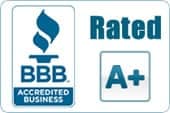So, you’re getting a new refrigerator with an ice maker, and you need an ice maker line. While it seems a pretty straight forward proposition, there are definitely some things you need to know before the fridge is delivered.
“Before the fridge is delivered” is more important than you might think. Believe it or not, there have been more than a few times where the phone has rang here at Allstar Plumbing and we have heard, “The delivery guys came to deliver my refrigerator, but they would not drop it off because we did not have a proper ice maker line.”
Yup, the guys actually took the fridge back to the warehouse and told the home owner to give them a call when they got a proper water line installed for it.
What is a “Proper” Ice Maker Line?
There are basically four ways to go with ice maker lines. Some are better than others, and at least one is definitely NOT recommended. That said, we will go over the 4 methods, their pros and cons, and let you make up your mind.
Saddle Valve under the house – I mention this first because, despite the fact that we do not recommend doing this, others seem to think it is just fine. Let’s look at the pros and cons.
Pros:
- This is basically a DIY project for most fairly handy people
- Requires very few tools
- Is even easier to do if you have a basement
Cons:
- It will almost definitely leak at some point (they are notorious for leaking)
- Since it is under your home, when it does leak, you will likely not notice until it has already done damage to your home
- If you need to turn the valve off, you need to do so from under your home (which means you will likely have to crawl if you do not have a basement)
- If you need to turn the valve off, it is very likely that the water will not turn off completely
- Cannot be installed in slab homes
In short, saddle valves are cheap, handyman-quality parts that are notorious for causing more problems than they solve.
Angle stop/straight stop under the house – This is where you have a plumber cut into a water line, install a tee and install an shutoff valve to service the ice maker line.
Pros:
- Much less likely to leak
- Can be a decent alternative if the following method is not feasible
- Will do a better job of actually turning the water to the ice maker completely off if needed
Cons:
- The biggest “con” here is that the shutoff is still under the house, making it problematic to maintain, and if there is a leak, making it harder to notice it.
- Cannot be installed on slab homes
This is a much better way to go than the saddle valve method. As you can see, it is still not quite ideal since the shut off is under the house.
Shutoff valve under the sink – This method involves either removing the cold water angle stop under the sink and replacing it with a 3-way valve or tying in a tee there and installing a second angle stop.
Pros:
- Pretty easy to get to for maintenance or to shut off the water
- Any leaks that may develop should be discovered fairly quickly
- Is less expensive than the 4th option (below)
- Uses a proper shut off valve
- Is good for use with an external filter system
Cons:
- Depending on which valve is used may require turning off cold water to kitchen sink to turn off water to ice maker line.
- Requires running the ice maker line behind cabinets or under house.
- Requires a fairly long ice maker line
- May not be feasible for all homes, depending on the layout
All in all, this is usually a pretty good choice; especially if using a shutoff valve that can turn the water off to the line without turning it off to the kitchen sink, and the fridge is close to the sink.
Wall box with accessible shutoff valve – This requires finding a cold water line to tie into. Then a ½” line is tied into it and ran to a location in the wall behind the fridge. A plastic or metal box that houses a shutoff valve is then installed.
Pros:
- This is the “cleanest” way to install a shutoff for an ice maker line. It looks great.
- It requires a very short ice maker line
- The shutoff valve is very accessible, and services only the line itself.
- Can be installed in pretty much any home, and is basically ran just like all of the other plumbing to the other fixtures
Cons:
- This is the priciest of the 4, and can be even more so depending on the layout of the home.
- Can be problematic if using an external filter
All in all, this is the best way to run an ice maker line. It is reliable, easy to access, works great, and looks like the house was built with it. The fact that it is set apart from the other fixtures means that if you choose to shut down the water to the fridge, no other fixtures are affected.
All that’s left is to decide who is going to come out to your home, discuss your options with you, give you a free estimate, and install your new ice maker line. Did you decide on Allstar Plumbing? If so, you made an awesome choice!




